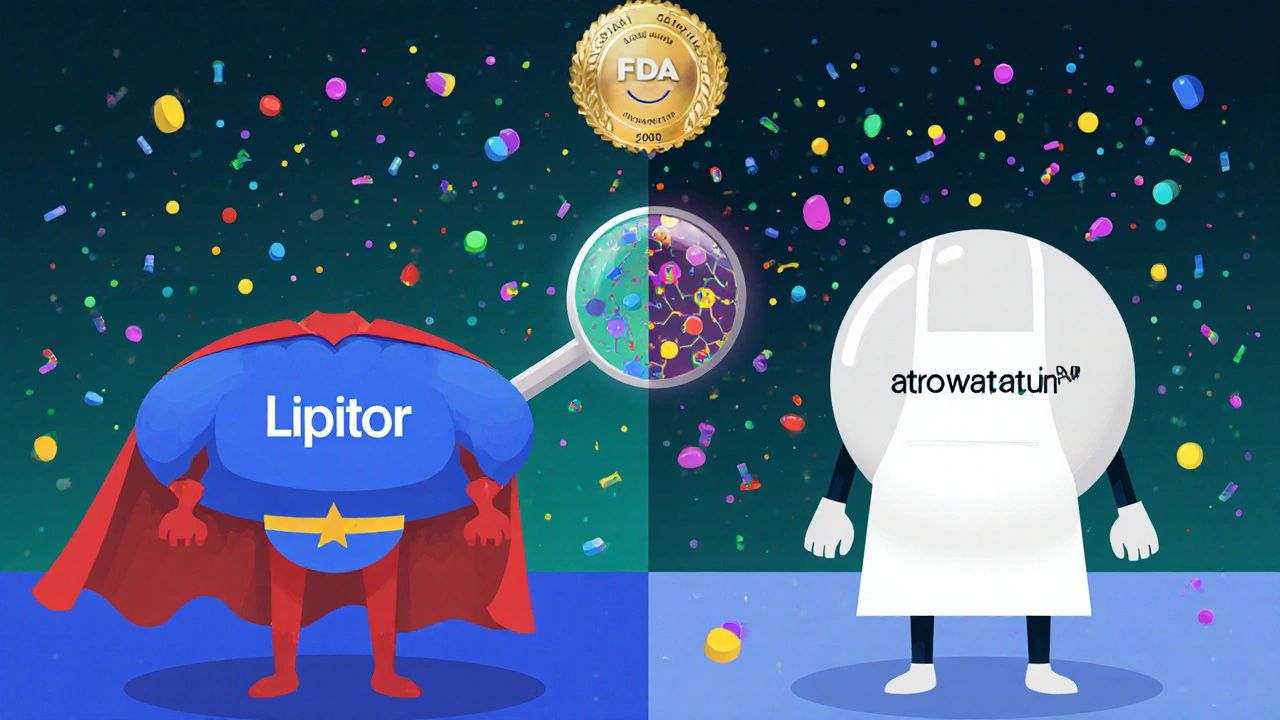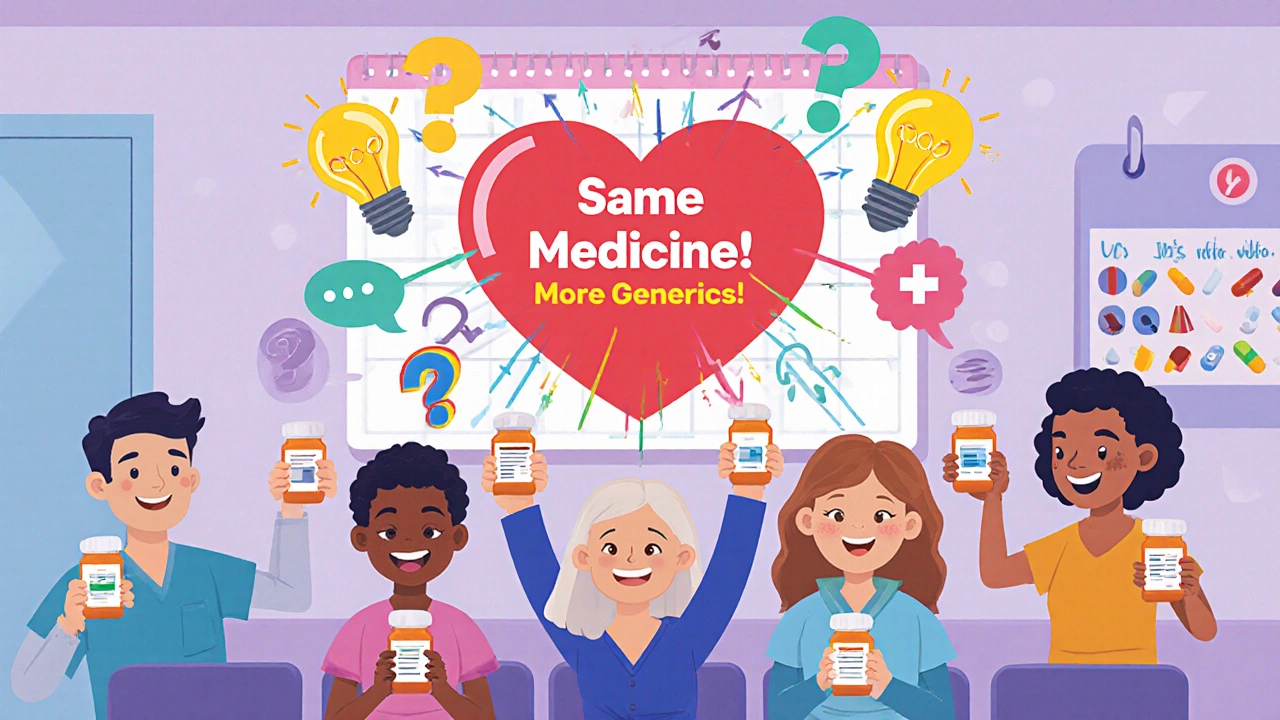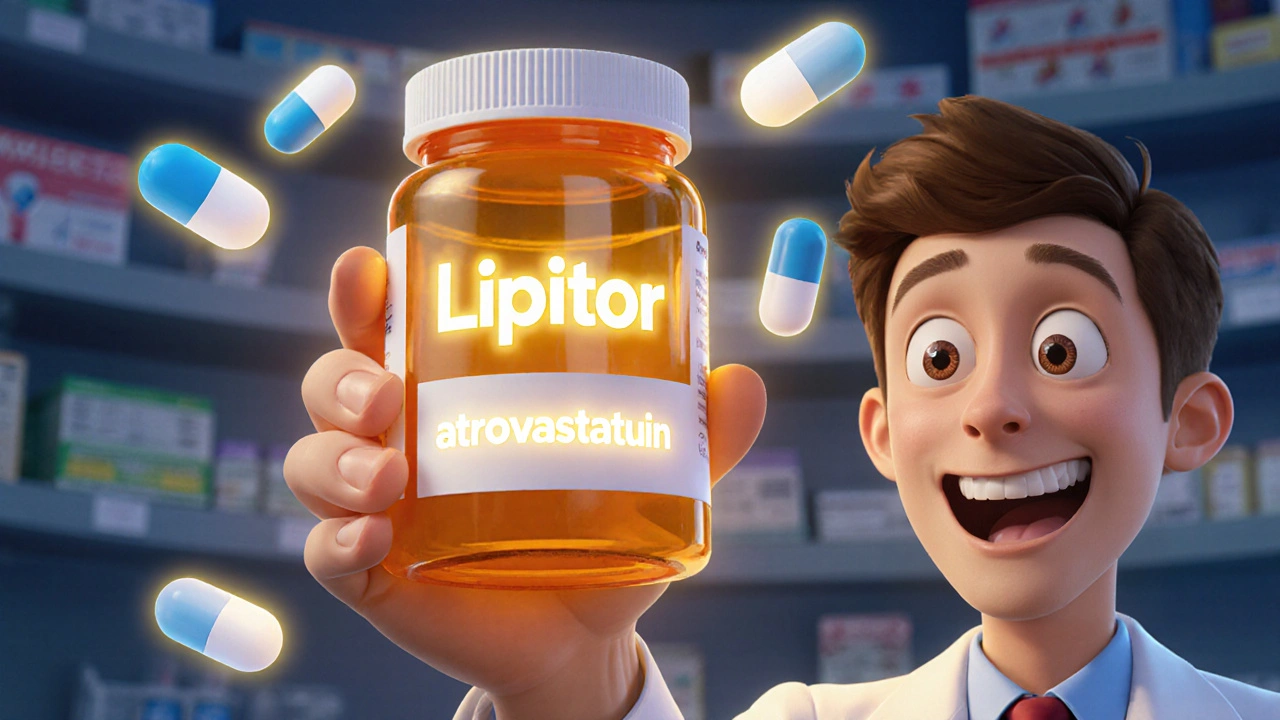Ever looked at your prescription bottle and wondered why there are two names on it? One big, bold, and familiar - like Lipitor. The other smaller, harder to pronounce - like atorvastatin. You’re not alone. Most people don’t realize these are the same medicine. And that misunderstanding can lead to confusion, worry, or even skipped doses.
What’s the Difference Between Generic and Brand-Name Drugs?
The active ingredient - the part that actually treats your condition - is exactly the same in both. Whether you take Lipitor or its generic version, atorvastatin, your body gets the same molecule, in the same amount, working the same way. The U.S. Food and Drug Administration (FDA) requires this. No exceptions.
Brand-name drugs are the original version created by a pharmaceutical company after years of research and clinical trials. That’s why they cost so much. Developing a new drug can run over $2.6 billion. The company gets a patent to protect its investment, usually for 20 years. Once that expires, other companies can make the same drug under its generic name.
Generic drugs don’t repeat those expensive trials. Instead, they prove they’re bioequivalent. That means they deliver the same amount of medicine into your bloodstream at the same rate as the brand. The FDA requires the 90% confidence interval for absorption to fall between 80% and 125% of the brand. That’s not a wide gap - it’s a tight, clinically safe range.
Why Do They Look Different?
Generic pills often look nothing like the brand. Lipitor is a blue oval. Atorvastatin might be a white round tablet with a score line. That’s not a mistake. It’s the law.
Trademark rules forbid generic manufacturers from copying the exact shape, color, or marking of brand-name pills. So they change it. That’s why you might get a different-looking pill each time you refill - even if the name on the label says the same thing.
These differences don’t affect how the drug works. But they can confuse patients. A 2022 CVS Health survey found that 24% of people worry their medication changed because the pill looks different. That’s why pharmacists are required to explain what’s happening - and why you should always ask if you’re unsure.
How Are They Labeled on Prescription Bottles?
By law, prescription labels must show both names. The brand name is usually bigger, on top. The generic name is smaller, underneath. For example:
- Prilosec (omeprazole)
- Prozac (fluoxetine)
- Metformin (Glucophage)
That’s the standard format. Ninety-two percent of U.S. pharmacies follow it, according to the National Association of Boards of Pharmacy. But not all patients notice the smaller text. If you’re unsure which is which, ask your pharmacist. You have the right to see both names clearly.
Some states, like California and New York, require pharmacists to print both names on the label - even if the prescription was written for the brand. Forty-one states have similar rules. If yours doesn’t, you can still request it. Pharmacists are trained to help you understand your meds.
Are Generic Drugs Really Just as Good?
Yes. And the evidence is overwhelming.
Nine out of every ten prescriptions filled in the U.S. are for generics. That’s not because pharmacies push them - it’s because patients and doctors trust them. The FDA doesn’t approve generics unless they meet the same strict quality, purity, and strength standards as brand-name drugs. Same manufacturing rules. Same inspections.
Studies show no difference in effectiveness or safety between generics and brands for the vast majority of drugs. A 2021 Kaiser Family Foundation study found that 78% of patients who were properly educated about generics reported being satisfied with them.
Cost? That’s where the real difference is. Lipitor costs around $300 a month as a brand. The generic? About $4. Sertraline (Zoloft) dropped from $450 to $5 monthly for one patient after switching. From 2007 to 2016, generics saved the U.S. healthcare system over $1.67 trillion.

When Might You Need the Brand Name?
There’s one exception: drugs with a narrow therapeutic index (NTI). These are medications where even tiny changes in blood levels can cause serious problems.
Examples include warfarin (Coumadin), levothyroxine (Synthroid), and some seizure medicines like phenytoin. For these, some doctors prefer to stick with the brand - not because generics are less effective, but because the margin for error is so small. Even a 5% difference in absorption could matter.
The FDA keeps a list of these drugs. Less than 1% of all medications fall into this category. But if you’re on one, talk to your doctor before switching. Your pharmacist can help too.
Why Do Some People Say Generics Don’t Work for Them?
People report different experiences. Some say their generic version made them feel different - more tired, more anxious, or even less effective.
Here’s the catch: it’s rarely the active ingredient. The problem is usually the inactive ingredients - things like dyes, fillers, or coatings. These don’t treat your condition, but they can affect how quickly the drug is absorbed. For most people, this doesn’t matter. But for a small group - especially those sensitive to changes in their body - it can cause noticeable differences.
Reddit threads, pharmacy forums, and patient surveys show this is a real concern. One 2023 thread on r/pharmacy with over 1,200 comments had people sharing stories of switching to generic metformin and feeling bloated or nauseated - symptoms that disappeared when they switched back.
If you notice a change after switching to a generic, don’t assume it’s all in your head. Talk to your pharmacist. Ask if the manufacturer changed. Ask if there’s another generic version available. Sometimes, a different brand of generic works better.
Who Makes Generic Drugs?
Surprise: About half of all generic drugs are made by the same companies that make the brand-name versions.
Kaiser Permanente’s 2023 guide confirms this. Pfizer, Novartis, and other big names often produce generics under different labels. The difference isn’t the maker - it’s the price tag. Generics are cheaper because they don’t need to spend millions on advertising or recouping R&D costs.
So when you take a generic, you might be getting the exact same pill - just without the fancy packaging and marketing.

What’s Changing in 2025?
More generics are coming. The FDA’s GDUFA III program is speeding up approvals, aiming for a 20% reduction in review time by 2027. That means more options, lower prices.
The Inflation Reduction Act of 2022 caps out-of-pocket drug costs for Medicare Part D at $2,000 a year starting in 2025. That will push even more seniors toward generics - especially since insulin, diabetes drugs, and heart medications are all now available as generics.
By 2026, experts predict 78% of all prescriptions will be generic. That’s up from today’s 90% volume share. Why? Because more biologic drugs - like those for arthritis or cancer - are losing patent protection. Biosimilars (the “generic” version of complex biologics) are starting to appear, priced 15-30% lower than the original.
What Should You Do?
- Check your bottle. Always look for both names. If you’re unsure, ask.
- Don’t panic if the pill looks different. It’s probably still the same medicine.
- Ask your pharmacist. They’re your best resource. A quick 5-minute chat can clear up confusion.
- Report side effects. If you feel different after switching, tell your doctor and pharmacist. It might be the filler, not the drug.
- Ask about cost. Generics save money. Always ask if a generic is available - even if your doctor didn’t prescribe one.
Medication labels are designed to inform you - not confuse you. The system works. But only if you know how to read it.
Frequently Asked Questions
Are generic drugs less effective than brand-name drugs?
No. Generic drugs must meet the same strict standards as brand-name drugs. The FDA requires them to have the same active ingredient, strength, dosage form, and bioequivalence. They work the same way in your body. Over 90% of prescriptions in the U.S. are for generics because they’re proven safe and effective.
Why do generic pills look different from brand-name ones?
Trademark laws prevent generic manufacturers from copying the exact color, shape, or marking of brand-name pills. This is to avoid confusion and protect brand identity. But these differences are only cosmetic. The active ingredient and how it works in your body are identical.
Can I ask for the brand-name drug instead of the generic?
Yes. Your doctor can write "dispense as written" or "do not substitute" on your prescription. But your insurance may charge you more - sometimes a lot more. Generics are cheaper because they don’t carry the cost of research and marketing. Unless your doctor says it’s medically necessary, the generic is usually the best choice.
Are there any drugs where I should avoid generics?
Only a small number - less than 1% - have a narrow therapeutic index (NTI), like warfarin, levothyroxine, or phenytoin. For these, even tiny changes in blood levels can matter. Some doctors prefer to stick with the brand, but many patients do fine on generics. Always talk to your doctor or pharmacist before switching.
Why do some people say generics made them feel worse?
It’s usually not the active ingredient. It’s the inactive ones - dyes, fillers, or coatings - that can affect how fast the drug is absorbed. Some people are sensitive to these. If you notice side effects after switching, talk to your pharmacist. They can check if a different generic manufacturer is available, or if the formula changed.
How do I know if my prescription was filled with a generic?
Look at the label. The brand name is usually larger and on top. The generic name - the active ingredient - is smaller and underneath. If you’re unsure, ask the pharmacist. They’re required to tell you if a generic was dispensed. In 41 states, they must list both names on the bottle.


12 Comments
Lexi Brinkley
I got my generic Lipitor last week and the pill looked like a tiny white pebble 😅 I almost threw it out thinking it was a mistake. My pharmacist laughed and said, "That’s your heart medicine, sweetie." Now I’m hooked on generics. Save $$$, same results. 🇺🇸💪
Kelsey Veg
ok so i just found out my zoloft is sertraline?? like wtf?? i thought they were different drugs?? i’ve been taking this for 5 years and never looked at the tiny text lmao. my mind is blown. also why does my pill change color every time?? feels like a magic trick 😵💫
Alex Harrison
I used to think generics were cheaper because they were lower quality. Then I switched my blood pressure med and didn’t notice a thing. My doctor even said the FDA checks them harder than most people think. Turns out I was the one being silly. Now I always ask for the generic. Saves me like $250 a month. Thanks for the clarity.
Jay Wallace
Let’s be real-Americans are too lazy to read labels. You don’t know the difference between atorvastatin and Lipitor? That’s not the pharmacy’s fault. That’s your fault. The FDA doesn’t hand out gold stars for ignorance. And before you say "I felt different," maybe it’s because you’re allergic to the dye in the generic. Not the drug. The DYE. Learn to read.
Alyssa Fisher
There’s something deeply human about how we attach meaning to shapes and colors. We don’t trust the white pill because it doesn’t look like the blue one we saw on TV. But the molecule doesn’t care about branding. It just does its job. Maybe the real issue isn’t the drug-it’s the culture that tells us expensive = better. That’s not science. That’s marketing.
Alyssa Salazar
The NTI drugs are the real kicker. I’m on warfarin and my INR went haywire when they switched me to a new generic. Turned out the fillers changed the absorption rate. My pharmacist had to call the manufacturer to confirm the batch. We switched back. Bottom line: generics are 99% fine-but for critical meds, don’t just roll the dice. Know your batch. Know your filler. Know your damn pharmacist.
Beth Banham
I never thought about this until my mom started taking generic metformin and said she felt "weird." She didn’t want to say anything because she didn’t want to be a bother. Took me two weeks to realize she was scared to ask. We went to the pharmacy together. Turned out it was a different manufacturer. Switched back. She’s fine now. Just… talk to people. It’s okay to ask.
Brierly Davis
Big shoutout to pharmacists-they’re the real MVPs. Last month I walked in confused as hell because my pill changed shape. The pharmacist didn’t just explain it-she pulled up the FDA bioequivalence chart on her tablet and showed me the data. I walked out feeling like a genius. Seriously, these people are unsung heroes. 🙌
Amber O'Sullivan
I switched to generic thyroid med and felt like a zombie for two weeks. Didn’t say anything because I thought I was imagining it. Then I found a Reddit thread. Same thing happened to 300 people. Switched back to brand. Back to normal. Why do we assume our bodies are wrong when the system is the problem
Jim Oliver
So let me get this straight. You’re mad because your $300 pill became a $4 pill… and now it’s a different color? You’re not a patient. You’re a brand loyalist with a credit card. The active ingredient is identical. The FDA approves it. The science is settled. Your emotional attachment to a blue oval is not a medical concern. Get over it.
William Priest
I’m not saying generics are bad. I’m saying the FDA’s 80-125% bioequivalence range is a joke. That’s a 45% window! If I took a drug that could be 45% weaker or stronger, I’d be on a rollercoaster. You call that science? I call it corporate roulette. And don’t even get me started on Indian factories. I’ve seen the inspection reports. It’s not pretty.
Ryan Masuga
I used to be scared of generics too. Then I started tracking my blood sugar on metformin and realized-no difference. Zero. My A1c stayed the same. My wallet got happier. I even asked my pharmacist to show me the FDA report. She did. It was boring. And that’s the point. The system works. You just gotta trust the data, not the logo. You got this.